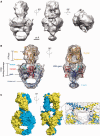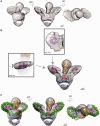Structural insight into negative DNA supercoiling by DNA gyrase, a bacterial type 2A DNA topoisomerase
- PMID: 23804759
- PMCID: PMC3763546
- DOI: 10.1093/nar/gkt560
Structural insight into negative DNA supercoiling by DNA gyrase, a bacterial type 2A DNA topoisomerase
Abstract
Type 2A DNA topoisomerases (Topo2A) remodel DNA topology during replication, transcription and chromosome segregation. These multisubunit enzymes catalyze the transport of a double-stranded DNA through a transient break formed in another duplex. The bacterial DNA gyrase, a target for broad-spectrum antibiotics, is the sole Topo2A enzyme able to introduce negative supercoils. We reveal here for the first time the architecture of the full-length Thermus thermophilus DNA gyrase alone and in a cleavage complex with a 155 bp DNA duplex in the presence of the antibiotic ciprofloxacin, using cryo-electron microscopy. The structural organization of the subunits of the full-length DNA gyrase points to a central role of the ATPase domain acting like a 'crossover trap' that may help to sequester the DNA positive crossover before strand passage. Our structural data unveil how DNA is asymmetrically wrapped around the gyrase-specific C-terminal β-pinwheel domains and guided to introduce negative supercoils through cooperativity between the ATPase and β-pinwheel domains. The overall conformation of the drug-induced DNA binding-cleavage complex also suggests that ciprofloxacin traps a DNA pre-transport conformation.
Figures





Similar articles
-
The acidic C-terminal tail of the GyrA subunit moderates the DNA supercoiling activity of Bacillus subtilis gyrase.J Biol Chem. 2014 May 2;289(18):12275-85. doi: 10.1074/jbc.M114.547745. Epub 2014 Feb 20. J Biol Chem. 2014. PMID: 24563461 Free PMC article.
-
The mechanism of negative DNA supercoiling: a cascade of DNA-induced conformational changes prepares gyrase for strand passage.DNA Repair (Amst). 2014 Apr;16:23-34. doi: 10.1016/j.dnarep.2014.01.011. Epub 2014 Feb 22. DNA Repair (Amst). 2014. PMID: 24674625 Review.
-
Gyrase containing a single C-terminal domain catalyzes negative supercoiling of DNA by decreasing the linking number in steps of two.Nucleic Acids Res. 2018 Jul 27;46(13):6773-6784. doi: 10.1093/nar/gky470. Nucleic Acids Res. 2018. PMID: 29893908 Free PMC article.
-
DNA gyrase with a single catalytic tyrosine can catalyze DNA supercoiling by a nicking-closing mechanism.Nucleic Acids Res. 2016 Dec 1;44(21):10354-10366. doi: 10.1093/nar/gkw740. Epub 2016 Aug 23. Nucleic Acids Res. 2016. PMID: 27557712 Free PMC article.
-
What makes a type IIA topoisomerase a gyrase or a Topo IV?Nucleic Acids Res. 2021 Jun 21;49(11):6027-6042. doi: 10.1093/nar/gkab270. Nucleic Acids Res. 2021. PMID: 33905522 Free PMC article. Review.
Cited by
-
The role of ATP-dependent machines in regulating genome topology.Curr Opin Struct Biol. 2016 Feb;36:85-96. doi: 10.1016/j.sbi.2016.01.006. Epub 2016 Jan 29. Curr Opin Struct Biol. 2016. PMID: 26827284 Free PMC article. Review.
-
CryoEM structures of open dimers of gyrase A in complex with DNA illuminate mechanism of strand passage.Elife. 2018 Nov 20;7:e41215. doi: 10.7554/eLife.41215. Elife. 2018. PMID: 30457554 Free PMC article.
-
Interactions between Gepotidacin and Escherichia coli Gyrase and Topoisomerase IV: Genetic and Biochemical Evidence for Well-Balanced Dual-Targeting.ACS Infect Dis. 2024 Apr 12;10(4):1137-1151. doi: 10.1021/acsinfecdis.3c00346. Epub 2024 Mar 5. ACS Infect Dis. 2024. PMID: 38606465 Free PMC article.
-
The toxin from a ParDE toxin-antitoxin system found in Pseudomonas aeruginosa offers protection to cells challenged with anti-gyrase antibiotics.Mol Microbiol. 2019 Feb;111(2):441-454. doi: 10.1111/mmi.14165. Epub 2018 Dec 5. Mol Microbiol. 2019. PMID: 30427086 Free PMC article.
-
Structure-Function Analysis Reveals the Singularity of Plant Mitochondrial DNA Replication Components: A Mosaic and Redundant System.Plants (Basel). 2019 Nov 21;8(12):533. doi: 10.3390/plants8120533. Plants (Basel). 2019. PMID: 31766564 Free PMC article. Review.
References
Publication types
MeSH terms
Substances
LinkOut - more resources
Full Text Sources
Other Literature Sources

